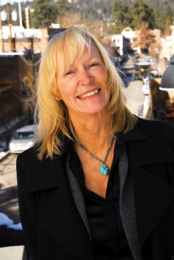
I am part of a very small minority of women: only three percent of top positions in the mainstream media (telecommunications, entertainment, publishing and advertising) are held by women. This amazing piece of information was presented to me via a documentary, Miss Representation, which aired in Bend recently.
The film offers startling statistics entwined with cohesive interviews with women leaders on the flood of negative imagery the media rolls out on a daily basis.
The eye opening and thought provoking film (written, directed and produced by Jennifer Siebel Newsom), served as an important refresher course in how the media portrays women. The documentary was graciously brought to us by Stacey Dodson, region president for U.S. Bank – Central & Eastern Oregon and was a welcome benefit for Saving Grace and BendFilm.
As a member of such an central group of women in the media I am wondering now, out loud, what it is that we can do to combat some of the alarming truths unveiled in this film including:
• The United States is 90th in the world in terms of women in national legislatures.
• Women hold 17 percent of the seats in the House of Representatives (the equivalent body in Rwanda is 56.3 percent female). Only 34 women have ever served as governors compared to 2,319 men. This number is being published before the November 7 election, but it’s unlikely the percentage will change much.
• According to Gloria Feldt, author of No Excuses, women are not getting elected because they lose, there are just not enough of them running for office. The percent has hardly changed in the last 20 years. At the rate we are progressing, it would take 70 years for women to reach parity in Congress. We might ask ourselves, what would our country look like if more women were in Congress making decisions?
• While women comprise 51 percent of the population, they make up only 15.7 percent of Fortune 500 boards of directors. Studies show companies with gender diversity at the top drive better financial performance on multiple measures – for example, 36 percent better stock price growth and 46 percent better return on equity.
• Women comprise seven percent of directors and 10 percent of film writers in the top 250 grossing films.
• Women own just six percent of the commercial broadcast TV stations in the U.S. and six percent of all full-power commercial broadcast radio stations in the U.S. Although women have been the majority of college journalism majors since 1977, the average male to female ratio for bylines at 11 of the top political and intellectual magazines is 7:1.
• Of the top 15 media corporations (which include a mix of print, online, television and radio businesses), all CEOs are male and only 17 percent of board members are women. Massive corporations such as The Walt Disney Company, CBS Corporation, Time Warner and Viacom, dominate the U.S. media landscape today and control everything we see, hear and read. They particularly control how women are presented in the media.
The focus of the documentary, however, was even more potent when it explored how mainstream media contributes to the under-representation of women in influential positions by perpetuating disparaging portrayals of women.
You can’t help but notice how the photographs of models are no longer just retouched in advertisements, but sometimes so digitally altered that the result is a distortion (beautiful or not) that is impossible to attain in reality. You can’t help but notice how broadcast ads are full of scantily clad women in provocative poses often doing really stupid things.
It’s not just advertising or entertainment segments, but the ‘reporting’ media continues to pit women running for office in clearly defining roles that men are not subjected to: remember the headline from New York Magazine juxtaposing Hillary Clinton and Sarah Palin: The Bitch and The Ditz. Why is it appropriate to focus on a female candidate’s physical appearance?
Some of the most powerful footage in the film comes from interviews with high school girls. Producer of the film, Jennifer Newsom, interviewed several teenagers for the film who indicated they are “frustrated and challenged, because the media is celebrating role models that aren’t necessarily healthy role models for young people.”
As a result it should be noted that 53 percent of 13-year-old girls are dissatisfied with their bodies. By age 17, that number increases to 78 percent. About two-thirds of women and girls have an eating disorder.
The media continues to “send us a message that a woman’s value lies in her beauty and sexuality, and not in her capacity to lead,” Newsom told ABC News.
“It would do all us a service if the media started to portray women who had really accomplished great things, healthy role models for young people,” said Newsom. “Then we’d start to value women more and you would start to see a cultural shift where women were seen as leaders.”
The day after I watched this film I received a really odd press release from a local company announcing a new associate. The release said: She has been described as “energetic, bright and inquisitive.” A new male associate received no such accolades.
And I remembered Stacy Dodson relating a personal story about her rise to leadership in the financial world. She was reminded of the recommendation she received from an ‘old school’ superior for a new position, “Stacey is a very nice girl who always dresses professionally.”
Dodson added, “That was the recommendation I got after being self-supporting through four years of college at Willamette University. Earning a double major in four years, while working 40 hours a week and serving as the president of my sorority. When I received that ‘recommendation,’ I had been employed with the company for almost seven years and had earned 100 percent scores on all my secret shoppers, had exceeded plan, quarter after quarter and been taking on increasingly demanding roles. Of course, I took his recommendation as a sign that I needed to align myself with another, more supportive manager. A couple years later, I was accepted into an even more challenging and prestigious leadership program.”
And, it should be noted, Dodson will be soon be joining other women executives to be honored as One of the Most Powerful Women in Banking. She adds, “Never let “em get you down!”
Where have all the bright and inquisitive women gone? They’re everywhere, they’re successful and progressive and changing the world everyday. They don’t need to be singled out from their male counterparts for their intelligence. They’re wondering why they are exposed in the media with such an out of touch mentality?
This is an important film for everyone, especially parents and teens, both boys and girls. It has reminded me, as a member of the media, to pay close attention to my pulpit. I encourage you to watch the trailer at https://vimeo.com/18985647. pha





